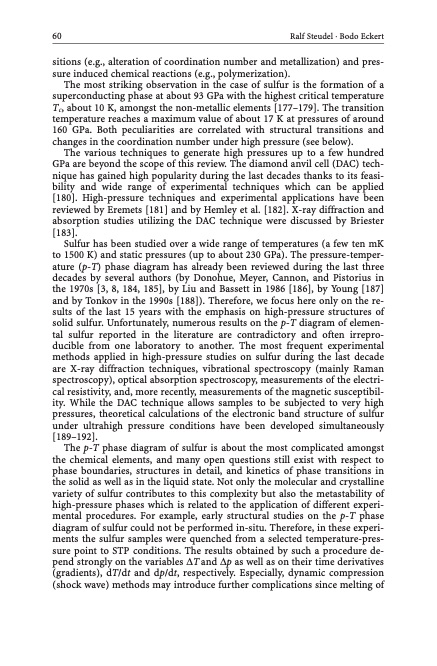
PDF Publication Title:
Text from PDF Page: 070
60 Ralf Steudel · Bodo Eckert sitions (e.g., alteration of coordination number and metallization) and pres- sure induced chemical reactions (e.g., polymerization). The most striking observation in the case of sulfur is the formation of a superconducting phase at about 93 GPa with the highest critical temperature Tc, about 10 K, amongst the non-metallic elements [177–179]. The transition temperature reaches a maximum value of about 17 K at pressures of around 160 GPa. Both peculiarities are correlated with structural transitions and changes in the coordination number under high pressure (see below). The various techniques to generate high pressures up to a few hundred GPa are beyond the scope of this review. The diamond anvil cell (DAC) tech- nique has gained high popularity during the last decades thanks to its feasi- bility and wide range of experimental techniques which can be applied [180]. High-pressure techniques and experimental applications have been reviewed by Eremets [181] and by Hemley et al. [182]. X-ray diffraction and absorption studies utilizing the DAC technique were discussed by Briester [183]. Sulfur has been studied over a wide range of temperatures (a few ten mK to 1500 K) and static pressures (up to about 230 GPa). The pressure-temper- ature (p-T) phase diagram has already been reviewed during the last three decades by several authors (by Donohue, Meyer, Cannon, and Pistorius in the 1970s [3, 8, 184, 185], by Liu and Bassett in 1986 [186], by Young [187] and by Tonkov in the 1990s [188]). Therefore, we focus here only on the re- sults of the last 15 years with the emphasis on high-pressure structures of solid sulfur. Unfortunately, numerous results on the p-T diagram of elemen- tal sulfur reported in the literature are contradictory and often irrepro- ducible from one laboratory to another. The most frequent experimental methods applied in high-pressure studies on sulfur during the last decade are X-ray diffraction techniques, vibrational spectroscopy (mainly Raman spectroscopy), optical absorption spectroscopy, measurements of the electri- cal resistivity, and, more recently, measurements of the magnetic susceptibil- ity. While the DAC technique allows samples to be subjected to very high pressures, theoretical calculations of the electronic band structure of sulfur under ultrahigh pressure conditions have been developed simultaneously [189–192]. The p-T phase diagram of sulfur is about the most complicated amongst the chemical elements, and many open questions still exist with respect to phase boundaries, structures in detail, and kinetics of phase transitions in the solid as well as in the liquid state. Not only the molecular and crystalline variety of sulfur contributes to this complexity but also the metastability of high-pressure phases which is related to the application of different experi- mental procedures. For example, early structural studies on the p-T phase diagram of sulfur could not be performed in-situ. Therefore, in these experi- ments the sulfur samples were quenched from a selected temperature-pres- sure point to STP conditions. The results obtained by such a procedure de- pend strongly on the variables DT and Dp as well as on their time derivatives (gradients), dT/dt and dp/dt, respectively. Especially, dynamic compression (shock wave) methods may introduce further complications since melting ofPDF Image | Topics in Current Chemistry

PDF Search Title:
Topics in Current ChemistryOriginal File Name Searched:
Elemental-Sulfur-und-Sulfur-Rich-Compounds-I.pdfDIY PDF Search: Google It | Yahoo | Bing
Sulfur Deposition on Carbon Nanofibers using Supercritical CO2 Sulfur Deposition on Carbon Nanofibers using Supercritical CO2. Gamma sulfur also known as mother of pearl sulfur and nacreous sulfur... More Info
CO2 Organic Rankine Cycle Experimenter Platform The supercritical CO2 phase change system is both a heat pump and organic rankine cycle which can be used for those purposes and as a supercritical extractor for advanced subcritical and supercritical extraction technology. Uses include producing nanoparticles, precious metal CO2 extraction, lithium battery recycling, and other applications... More Info
| CONTACT TEL: 608-238-6001 Email: greg@infinityturbine.com | RSS | AMP |